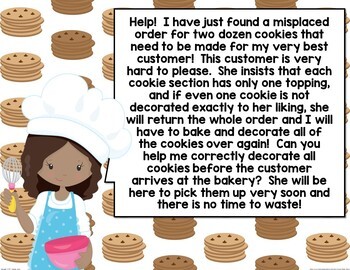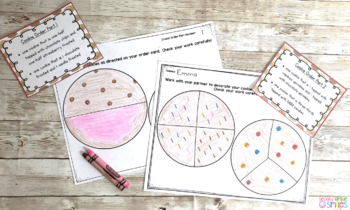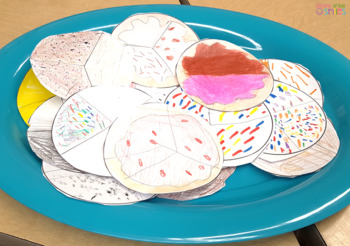Cookie Fractions | Hands-On Fractions Activity | Fractions PBL
- PDF
What educators are saying
Description
This hands-on fraction lesson assigns students the task of helping fictional Chef Cate, who needs to quickly fill a cookie order for a very hard-to-please customer. It's a fun and engaging way to incorporate a real world connection into your fraction unit!
To begin this lesson, simply display Chef Cate’s direction slide from your classroom computer using a document camera or print it out and read it to your class.
Students then work in pairs or individually to fill specific parts of the cookie order. Each student or student pair is tasked with partitioning their cookies into any combination of halves, thirds, and fourths and decorating each cookie according to the directions given on their task card. As students work, you have the opportunity to walk through the room, ask students to explain their work, and address any misconceptions. Twelve task cards are included in both color and black and white options.
When finished, you can review student work by checking their task cards and cookies yourself, or allow students to present their cookies and task card and ask the class to check that the order is properly filled before the customer picks it up. I like to do this on the document camera and have the rest of the class give a thumbs up or thumbs down to indicate agreement or disagreement. If students have made an error, this is a great opportunity for a classmate to explain it to them and to allow time to fix it and learn from the mistake. Just for fun, I have my students add approved cookies to a cookie tray and ship them off to Chef Cate.
---
This lesson addresses the following Common Core Standards:
CCSS.MATH.CONTENT.2.G.A.3: Partition circles and rectangles into two, three, or four equal shares, describe the shares using the words halves, thirds, half of, a third of, etc., and describe the whole as two halves, three thirds, four fourths. Recognize that equal shares of identical wholes need not have the same shape.
CCSS.MATH.CONTENT.3.NF.A.1: Understand a fraction 1/b as the quantity formed by 1 part when a whole is partitioned into b equal parts; understand a fraction a/b as the quantity formed by a parts of size 1/b.
CCSS.MATH.CONTENT.3.G.A.2: Partition shapes into parts with equal areas. Express the area of each part as a unit fraction of the whole. For example, partition a shape into 4 parts with equal area, and describe the area of each part as 1/4 of the area of the shape.
---
If you enjoy this product, please consider following my store. I post new products and freebies regularly! You can contact me with any questions or requests at secondgradesmilesstore@gmail.com.
Thank you,
Amanda Taylor @ Second Grade Smiles





